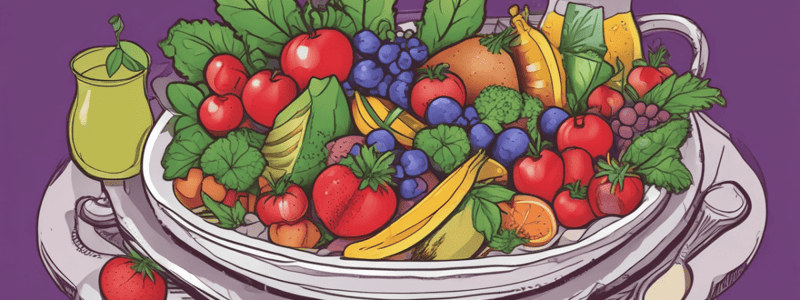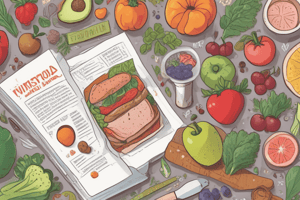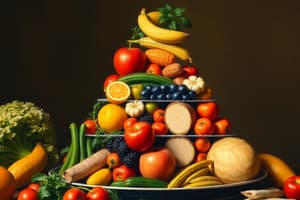Podcast
Questions and Answers
What are the primary macronutrients found in grains?
What are the primary macronutrients found in grains?
Carbohydrate (starch) and protein
What is a serving size of a grain food equivalent to?
What is a serving size of a grain food equivalent to?
1 slice of bread, 1 cup of ready-to-eat cereal, or ½ cup of cooked rice, pasta, or cereal such as oatmeal
Why do dietary guides recommend choosing whole grains over refined grains?
Why do dietary guides recommend choosing whole grains over refined grains?
Because they naturally contain more fiber and other various nutrients
What are some examples of grain products?
What are some examples of grain products?
What are the main ingredients of grains?
What are the main ingredients of grains?
Why is corn sometimes classified as a vegetable?
Why is corn sometimes classified as a vegetable?
What is the purpose of dietary guides?
What is the purpose of dietary guides?
What are the major food groups usually classified into?
What are the major food groups usually classified into?
What are whole grains according to the FDA?
What are whole grains according to the FDA?
What is the difference between enrichment and fortification of grains?
What is the difference between enrichment and fortification of grains?
Why are dairy products good sources of several vitamins and minerals?
Why are dairy products good sources of several vitamins and minerals?
What is the fat content of low-fat milk compared to whole milk?
What is the fat content of low-fat milk compared to whole milk?
What is the protein content of dairy products?
What is the protein content of dairy products?
What are some examples of protein-rich foods?
What are some examples of protein-rich foods?
How much iron and zinc are absorbed by the body from animal foods compared to plant foods?
How much iron and zinc are absorbed by the body from animal foods compared to plant foods?
What are some protein-rich foods that can substitute for meat?
What are some protein-rich foods that can substitute for meat?
What are some examples of fruits?
What are some examples of fruits?
Why are fruits and vegetables important for a healthy diet?
Why are fruits and vegetables important for a healthy diet?
What is one serving of food from the fruit group equal to?
What is one serving of food from the fruit group equal to?
Why are whole or cut-up fruits considered healthier options than juices?
Why are whole or cut-up fruits considered healthier options than juices?
What are some ways vegetables can be consumed?
What are some ways vegetables can be consumed?
Why is it important to choose a variety of foods from each food group?
Why is it important to choose a variety of foods from each food group?
What types of fats are classified as 'healthy' fats?
What types of fats are classified as 'healthy' fats?
What are solid fats, and what is their association with cardiovascular disease?
What are solid fats, and what is their association with cardiovascular disease?
What do sugary foods and beverages typically supply?
What do sugary foods and beverages typically supply?
Why is processing necessary for raw foods?
Why is processing necessary for raw foods?
What is an example of a minimally processed food?
What is an example of a minimally processed food?
What is the main difference between fresh carrots and frozen or canned carrots?
What is the main difference between fresh carrots and frozen or canned carrots?
What is the primary purpose of additives in ultra-processed foods?
What is the primary purpose of additives in ultra-processed foods?
What is a characteristic of an ultra-processed food like the frozen carrot cake shown in Figure 3.5b?
What is a characteristic of an ultra-processed food like the frozen carrot cake shown in Figure 3.5b?
Why are nutrition experts concerned about diets that include high amounts of ultra-processed foods?
Why are nutrition experts concerned about diets that include high amounts of ultra-processed foods?
How can consumers determine whether a food is minimally processed or ultra-processed?
How can consumers determine whether a food is minimally processed or ultra-processed?
What is a key difference between minimally processed and ultra-processed foods?
What is a key difference between minimally processed and ultra-processed foods?
What is a notable feature of the ingredients' list of the commercially prepared carrot cake shown in Figure 3.5b?
What is a notable feature of the ingredients' list of the commercially prepared carrot cake shown in Figure 3.5b?
Why do consumers need to be aware of the level of processing in the foods they eat?
Why do consumers need to be aware of the level of processing in the foods they eat?
What is the current status of the FDA's definitions for categorizing processed foods, according to their level of processing?
What is the current status of the FDA's definitions for categorizing processed foods, according to their level of processing?
Flashcards are hidden until you start studying
Study Notes
Major Food Groups
- There are five major food groups: grains, dairy products, fruits, vegetables, and protein-rich foods
- Each group provides key nutrients and has specific serving sizes
- Dietary guides recommend choosing whole grains, minimally processed foods, and a variety of foods from each group
Grains
- Include products made from wheat, rice, and oats
- Examples: pasta, noodles, flour tortillas, bread, cereal
- Serving size: 1 slice of bread, 1 cup of ready-to-eat cereal, or ½ cup of cooked rice, pasta, or cereal
- Whole grains contain more fiber and nutrients than refined grains
- Refined grain products can be enriched or fortified with vitamins and minerals
Dairy Products
- Include milk and products made from milk that retain calcium content
- Examples: yogurt, hard cheeses, milk-based desserts (e.g. ice cream, pudding)
- Serving size: 1 cup of milk or equivalent (e.g. 1 cup of plain, low-fat yogurt or frozen yogurt)
- Dairy products are excellent sources of protein, phosphorus, and riboflavin
- Choose fat-free or low-fat milk and dairy products
Protein-Rich Foods
- Include beef, pork, lamb, fish, shellfish, poultry, beans, eggs, nuts, and seeds
- Serving size: 1 ounce of meat, poultry, or fish; ¼ cup cooked dry beans or dry peas; 1 egg; 1 tablespoon of peanut butter; or ½ ounce of nuts or seeds
- Protein-rich foods are good sources of micronutrients, especially iron, zinc, and B vitamins
Fruits
- Include fresh, dried, frozen, sauced, and canned fruit, as well as 100% fruit juice
- Serving size: 1 cup of fruit or fruit juice, or ½ cup of dried fruit
- Fruits are low in fat and good sources of phytochemicals and micronutrients, especially potassium and vitamins C and folate
- Choose whole or cut-up fruits instead of juices
Vegetables
- Include fresh, cooked, canned, frozen, and dried/dehydrated vegetables, and 100% vegetable juice
- Serving size: 1 cup of raw or cooked vegetables, 1 cup vegetable juice, or 2 cups of uncooked leafy greens
- Vegetables are good sources of micronutrients, fiber, and phytochemicals
- Choose a variety of vegetables, including dark green, orange and red, starchy, and "other" categories
Other Foods
- Oils include canola, corn, and olive oils, as well as other fats that are liquid at room temperature
- Sugary foods ("sweets") include candy, regular soft drinks, jelly, and other foods with high amounts of added sugar
- Choose "healthy" fats, such as nuts, seeds, and avocados, instead of saturated fats
Levels of Food Processing
- Raw foods can undergo different levels of processing, including refinement, before being eaten
- Minimally processed foods contain few refined ingredients and are closer to their natural state
- Ultra-processed foods contain numerous additives and are often high in sugar, salt, and unhealthy fats
- Nutrition experts are concerned about the negative health effects of eating diets high in ultra-processed foods
Studying That Suits You
Use AI to generate personalized quizzes and flashcards to suit your learning preferences.




